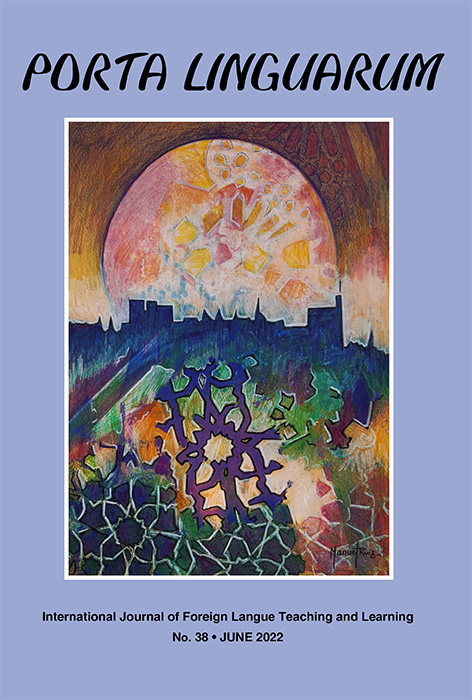How to keep the current flowing? factors contributing to the longevity of directed motivational currents
DOI:
https://doi.org/10.30827/portalin.vi38.23596Keywords:
directed motivational currents, motivation, vision, re-triggering mechanisms, autonomyAbstract
Directed motivational currents (DMCs) depict long-term, heightened engagement in pursuit of a highly desired future identity. While the core theoretical underpinnings of the construct are well-established and it is possible to observe a growing research interest in inducing real-time currents, especially in the foreign language (FL) context, little is known regarding the specific factors contributing to the untypical longevity of DMCs, as the currents are believed to cover timescales of months or even years. This mixed-method study is therefore an attempt to fill the void in the DMC-related research. Following the initial phase of the investigation, which sought to identify prospective DMC cases amongst 247 students of English as a foreign language (EFL) at private language schools, thematic analysis was applied to scrutinise the exact nature of DMC experiences identified. The investigation showed that the flow of motivational energy within the DMC superstructure might be occasionally obstructed by both mental and physical exhaustion and, thus, re-triggering mechanisms are required to maintain the intensity of motivational surges. Two primary factors contributing to the longevity of DMCs were identified, namely the growth of learners’ agency and the re-emergence of one’s superordinate goal.
Downloads
References
Braun, V., & Clarke, V. (2006). Using thematic analysis in psychology. Qualitative Research in Psychology, 3, 77-101. https://doi.org/ 10.1191/1478088706qp063oa
Cohen, L., Manion, L., & Morrison, K. (2000). Research Methods in Education. London: Routledge Farmer.
Dörnyei, Z., & Kubanyiova, M. (2014). Motivating learners, motivating teachers: Building vision in the language classroom. Cambridge University Press.
Dörnyei, Z., Ibrahim, Z., & Muir, Ch. (2015). Directed Motivational Currents: Regulating complex dynamic systems through motivational surges. In Z. Dőrnyei, P.D. MacIntyre & A. Henry (Eds.), Motivational Dynamics in Language Learning (pp. 95-108). Multilingual Matters.
Dörnyei, Z. (2016). Motivation. In M. Lamb (Ed.). The Routledge Handbook of English Language Teaching (pp. 324-338). Routledge.
Dörnyei, Z., Henry, A., & Muir, Ch. (2016). Motivational currents in language learning: Frameworks for focused interventions. Routledge.
Garcia-Pinar, A. (2020). Group Directed Motivational Currents: transporting undergraduates toward highly valued end goals. The Language Learning Journal, 1-13. https://doi.org/10.1080/09571736.2020.1858144
Henry, A., Davydenko, S., & Dőrnyei, Z. (2015). The anatomy of directed motivational currents: Exploring intense and enduring periods of L2 motivation. The Modern Language Journal, 99, 329-345. http://dx.doi.org/10.1111/modl.12214
Henry, A. (2019). Directed Motivational Currents: extending the theory of L2 vision. In M. Lamb (Ed.). The Palgrave Handbook of Motivation for Language Learning (pp.139-161). Palgrave MacMillan.
Ibrahim, Z. (2016). Affect in Directed Motivational Currents: Positive emotionality in long-term L2 engagement. In P.D. MacIntyre, T. Gregersen & S. Mercer (Eds.), Positive Psychology in SLA (pp.258-281). Multilingual Matters. http://dx.doi.org/10.21832/9781783095360-012
Ibrahim, Z. (2017). Parameters inducing motivational surges in second language learning. UKH Journal of Social Sciences, 1, 24-33. http://doi.org/10.25079/ukhjss.v1n1y2017.
Ibrahim, Z. (2020). Sustained flow: Affective obsession in second language learning. Frontiers in Psychology, 10, 1-13. https://doi.org/10.3389/fpsyg.2019.02963
Jahedizadeh, S., Ghonsooly, B., & Ghanizadeh, A. (2021). A model of language students’ sustained flow, personal best, buoyancy, evaluation apprehension, and academic achievement. Porta Linguarum, 35, 257-275. https://doi.org/10.30827/portalin.v0i35.1575
Li, C., Tang, L., & Zhang, S. (2021). Understanding Directed Motivational Currents among Chinese EFL students at a Technological University. International Journal of Instruction, 14(2), 953-968. https://doi.org/10.29333/iji.2021.14254a
Muir, Ch. (2016). The dynamics of intense long-term motivation in language learning: Directed Motivational Currents in theory and practice. (PhD thesis). University of Nottingham, England.
Muir, Ch, & Gümüş, O. (2020). Directed Motivational Currents: An agenda for future research. Eurasian Journal of Applied Linguistics, 6(3), 501-519. https://doi.org/10.32601/ejal.834661
Nowell, L., Norris J., White, D., & Moules, N. (2017). Thematic analysis: Striving to meet the trustworthiness criteria. The International Journal of Qualitative Methods, 16, 1-13. https://doi.org/10.1177%2F1609406917733847
Pietluch, A. (2018). Extraordinary motivation or a high sense of personal agency: The role of self-efficacy in the Directed Motivational Currents theory. New Horizons in English Studies, 3, 45-56. http://dx.doi.org/10.17951/nh.2018.3.45
Pietluch, A. (2021). Energising Directed Motivational Currents through learners’ agency. Peter Lang GmBH.
Safdari, S., & Maftoon, P. (2017). The rise and fall of Directed Motivational Currents: A case study. The Journal of Language Learning and Teaching, 7(1), 43-54.
Sak, M. (2019). Contextual factors that enhance and impair Directed Motivational Currents in instructed L2 settings. Research on Youth and Language, 13(2), 155-174.
Selçuk, Ö., & Erten,İ. H. (2017). A display of patterns of change in learners' motivation: Dynamics perspective. Research on Youth and Language, 11, 128–141.
Watkins, J. (2016). Planning a curriculum to stimulate Directed Motivational Currents (DMCs). Kwansei Gakuin University Repository, 19, 59-73.
Zarrinabadi, N., & Tavakoli, M. (2017). Exploring motivational surges among Iranian EFL teacher trainees: Directed motivational currents in focus. TESOL Quarterly, 51, 155-166. https://doi.org/10.1002/tesq.332
Zarrinabadi, N., Ketabi, S., & Tavakoli, M. (2019). Directed Motivational Currents in L2: Exploring the effects on self and communication. Springer.
Zarrinabadi, N., & Khajeh, F. (2021). Describing characteristics of group-level directed motivational currents in EFL contexts. Current Psychology, 1-10. https://doi.org/10.1007/s12144-021-01518-9



















